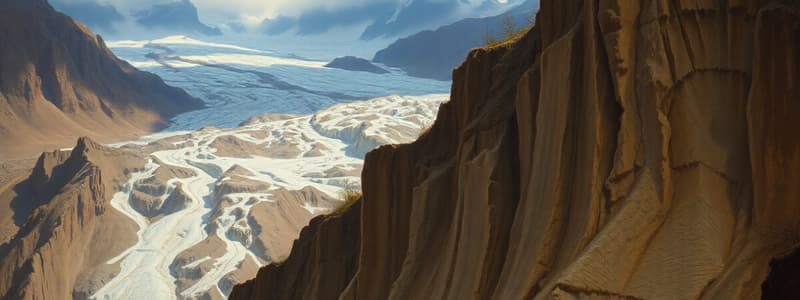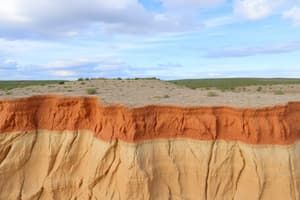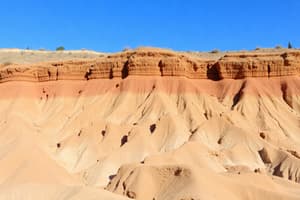Podcast
Questions and Answers
How does thermal erosion differ from glacial erosion in terms of the materials eroded and the temperature conditions under which each occurs?
How does thermal erosion differ from glacial erosion in terms of the materials eroded and the temperature conditions under which each occurs?
Thermal erosion involves the erosion of permafrost due to warm temperatures, leading to the breakup of coastlines. Glacial erosion involves the grinding and scraping away of rocks and soil by glaciers in frigid areas.
Explain how the size of waves and the tidal range influence the distribution of sediments on a coastline.
Explain how the size of waves and the tidal range influence the distribution of sediments on a coastline.
Larger waves carry more energy and can move larger sediments or particles of rock. A large tidal range allows waves to deposit materials farther inland, whereas a low tidal range results in materials being deposited closer to the shore.
Describe how wind contributes to both the formation and the erosion of landforms.
Describe how wind contributes to both the formation and the erosion of landforms.
Wind can form landforms by carrying sand and creating dunes. It also causes erosion by blowing soil off of dry land and by throwing sand and soil at rocks, gradually changing their shape.
Why are coastlines with small, narrow beaches more susceptible to rapid changes compared to coastlines with big beaches?
Why are coastlines with small, narrow beaches more susceptible to rapid changes compared to coastlines with big beaches?
In what ways do pollution, oil spills, and garbage affect coastlines, and what are the broader implications of these effects?
In what ways do pollution, oil spills, and garbage affect coastlines, and what are the broader implications of these effects?
Flashcards
What is a coastline?
What is a coastline?
The meeting point of land and sea or oceans, including beaches, cliffs, capes, caves, bays, and estuaries.
What is Thermal Erosion?
What is Thermal Erosion?
Erosion of permafrost along a river or coastline caused by warm temperatures that break off chunks of ice-rich land.
What is a headland?
What is a headland?
A tapering strip of land jutting into the sea
What is a tombolo?
What is a tombolo?
Signup and view all the flashcards
What are Tides?
What are Tides?
Signup and view all the flashcards
Study Notes
- Weather and erosion are natural processes that shape the Earth's surface
Weather and Erosion
- Wind carries sand and other small particles over distances, forming sand dunes and eroding farmland
- Over time, windblown sand and soil can change the shape of rocks
Erosion by Ice
- Glaciers erode the earth and create landforms in cold regions and mountaintops
- Glaciers move slowly downhill, transporting materials from tiny grains to large boulders
- Rocks carried by glaciers scrape against the ground, eroding both the ground and rocks
Thermal Erosion
- Thermal erosion is the erosion of permafrost along rivers or coastlines
- Warm temperatures cause ice-rich permafrost to break off coastlines in large chunks, carrying topsoil and vegetation
- Eroded "floating islands" can disintegrate into the ocean or crash into other land, spreading new life
What is a coastline?
- A coastline is where land meets the sea or ocean
- Coastlines include beaches, cliffs, capes, caves, bays, and estuaries
- These features can be located close together along a coastline
- Smaller landforms can be lined up along a coast
Coastal Features
- Natural arch: An arch hollowed out of a headland by the sea
- Rocky islet: a small island made of rock
- Stack: Needle-shaped column of rock resulting from the collapse of an arch
- Spit: Elongated ridge of sand or pebbles extending into the water
- Cliff: steep rock face shaped by a sea
- Headland: a tapering strip of land jutting into the sea
- Tombolo: Ridge of sand joining an island to the shoreline
- Beach: Accumulation of sand or pebbles along a coast
- Dune: Accumulation of sand shaped by the wind
- Cave: Natural underground cavity formed by water erosion
Rivers and tides
- River estuary: Mouth of a river influenced by tides, forming an indentation in the coastline that varies in width and depth
- Lagoon: Shallow expanse of seawater separated from the sea by a ridge of sand or a barrier island
Coastal Processes
- The coast is the land along a sea, and the coastline is the boundary where land meets water
- Waves, tides, and currents create and modify coastlines
- Waves erode the land but can also leave behind materials like shells and seaweed
Long term effect on Coastlines
- Coastal changes occur over long periods
- The hardness of the material determines how easily a coast erodes; harder materials like granite are more resistant
- Tides affect sediment deposition on the coast
- Areas with large tidal ranges have sediment deposited farther inland
- High-energy waves carry more sediment and rock particles
Factors shaping the coastlines
- Larger waves carry more energy and move more sediment or rock particles
- Coastlines with big beaches allow waves to spread out energy and deposits
- Small beaches focus wave energy, resulting in a tattered appearance
- Strong storms can crack rocky coastlines and wash away sandy beaches
Changing Coastlines
- Coasts can indicate natural events like weather patterns and sea level changes
- Storms can cause flooding in coastal areas
- Coastal plains are flat, low-lying lands exposed when sea levels decrease
- Coasts can be affected by pollution, oil spills, and garbage, which negatively impact their appearance and marine life
Studying That Suits You
Use AI to generate personalized quizzes and flashcards to suit your learning preferences.




